Spatiotemporal Changes of Winter Wheat Planted and Harvested Areas, Photosynthesis and Grain Production in the Contiguous United States from 2008–2018
Abstract
1. Introduction
2. Materials and Methods
2.1. Study Area
2.2. Winter Wheat Planted and Harvested Areas, and Grain Production Data from 2008–2018 from the USDA NASS Statistical Dataset
2.3. Winter Wheat Planted Area Data from the USDA NASS Cropland Data Layer Dataset (CDL)
2.4. Gross Primary Production Estimates for Winter Wheat from the Vegetation Photosynthesis Model (GPPVPM)
2.5. Statistical Analysis
2.6. In-Season Forecasting of Winter Wheat Grain Production Using Cumulated GPPVPM Data
3. Results
3.1. Spatiotemporal Consistency of Winter Wheat Planted and Harvested Areas from 2008–2018
3.2. Spatiotemporal Dynamics of GPPVPM and Grain Production from NASS Dataset from 2008–2018
3.3. The Relationships between County-Level GPPVPM and Winter Wheat Grain Production from 2008 to 2018
3.4. In-Season Forecasting of Winter Wheat Grain Production Using Cumulative GPP Data
4. Discussion
4.1. Spatiotemporal Dynamics of Winter Wheat Planted Area, GPP, and Grain Production
4.2. Spatiotemporal Consistency of Winter Wheat Cropping Areas from the CDL and NASS Datasets
4.3. Harvest Index—The Relationship between Winter Wheat Grain Production and GPPVPM
4.4. In-Season Forecasting for Winter Wheat Grain Production
5. Conclusions
Author Contributions
Funding
Institutional Review Board Statement
Informed Consent Statement
Data Availability Statement
Acknowledgments
Conflicts of Interest
References
- Mitchell, D.O.; Mielke, M. Wheat: The global market, policies, and priorities. Glob. Agric. Trade Dev. Ctries. 2005, 195–214. [Google Scholar]
- USDA FAS. World Agricultural Production; USDA, Ed.; USDA Foreign Agriculture Service: Washington, DC, USA, 2020.
- USDA NASS. USDA Crop Production 2014 Summary; USDA: Washington, DC, USA, 2014; Volume 1.
- ADB. Results of the Methodological Studies for Agricultural and Rural Statistics; Asian Development Bank: Mandaluyong City, Philippines, 2015. [Google Scholar]
- Carfagna, E.; Carfagna, A. Alternative Sampling Frames and Administrative Data. What is the Best Data Source for Agricultural Statistics? Agric. Surv. Methods 2010. [Google Scholar] [CrossRef]
- USDA NASS. The Yield Forecasting Program of NASS; USDA, Ed.; NASS Staff Report No. SMB 12-01; USDA: Washington, DC, USA, 2012.
- USDA NASS/WAOB. Understanding USDA Crop Forecasts; USDA, Ed.; Miscellaneous Publication: Washington, DC, USA, 1999; No.1554.
- De Groote, H.; Traore, O. The cost of accuracy in crop area estimation. Agric. Syst. 2005, 84, 21–38. [Google Scholar] [CrossRef]
- Mulla, D.J. Twenty five years of remote sensing in precision agriculture: Key advances and remaining knowledge gaps. Biosyst. Eng. 2013, 114, 358–371. [Google Scholar] [CrossRef]
- Shelestov, A.; Lavreniuk, M.; Kussul, N.; Novikov, A.; Skakun, S. Exploring Google Earth Engine Platform for Big Data Processing: Classification of Multi-Temporal Satellite Imagery for Crop Mapping. Front. Earth Sci. 2017, 5, 1–10. [Google Scholar] [CrossRef]
- Orynbaikyzy, A.; Gessner, U.; Conrad, C. Crop type classification using a combination of optical and radar remote sensing data: A review. Int. J. Remote Sens. 2019, 40, 6553–6595. [Google Scholar] [CrossRef]
- Massey, R.; Sankey, T.T.; Congalton, R.G.; Yadav, K.; Thenkabail, P.S.; Ozdogan, M.; Sánchez Meador, A.J. MODIS phenology-derived, multi-year distribution of conterminous U.S. crop types. Remote Sens. Environ. 2017, 198, 490–503. [Google Scholar] [CrossRef]
- Zhong, L.; Hu, L.; Zhou, H.; Tao, X. Deep learning based winter wheat mapping using statistical data as ground references in Kansas and northern Texas, US. Remote Sens. Environ. 2019, 233, 111411. [Google Scholar] [CrossRef]
- Skakun, S.; Franch, B.; Vermote, E.; Roger, J.-C.; Becker-Reshef, I.; Justice, C.; Kussul, N. Early season large-area winter crop mapping using MODIS NDVI data, growing degree days information and a Gaussian mixture model. Remote Sens. Environ. 2017, 195, 244–258. [Google Scholar] [CrossRef]
- Boryan, C.; Yang, Z.; Mueller, R.; Craig, M. Monitoring US agriculture: The US Department of Agriculture, National Agricultural Statistics Service, Cropland Data Layer Program. Geocarto Int. 2011, 26, 341–358. [Google Scholar] [CrossRef]
- Lobell, D.B.; Azzari, G.; Burke, M.; Gourlay, S.; Jin, Z.; Kilic, T.; Murray, S. Eyes in the Sky, Boots on the Ground: Assessing Satellite- and Ground-Based Approaches to Crop Yield Measurement and Analysis. Am. J. Agric. Econ. 2020, 102, 202–219. [Google Scholar] [CrossRef]
- Guan, K.Y.; Wu, J.; Kimball, J.S.; Anderson, M.C.; Frolking, S.; Li, B.; Hain, C.R.; Lobe, D.B. The shared and unique values of optical, fluorescence, thermal and microwave satellite data for estimating large-scale crop yields. Remote Sens. Environ. 2017, 199, 333–349. [Google Scholar] [CrossRef]
- Deines, J.M.; Patel, R.; Liang, S.; Dado, W.; Lobell, D.B. A million kernels of truth: Insights into scalable satellite maize yield mapping and yield gap analysis from an extensive ground dataset in the US Corn Belt. Remote Sens. Environ. 2021, 253, 112174. [Google Scholar] [CrossRef]
- Karthikeyan, L.; Chawla, I.; Mishra, A.K. A review of remote sensing applications in agriculture for food security: Crop growth and yield, irrigation, and crop losses. J. Hydrol. 2020, 586. [Google Scholar] [CrossRef]
- Zhuo, W.; Huang, J.X.; Li, L.; Zhang, X.D.; Ma, H.Y.; Gao, X.R.; Huang, H.; Xu, B.D.; Xiao, X.M. Assimilating Soil Moisture Retrieved from Sentinel-1 and Sentinel-2 Data into WOFOST Model to Improve Winter Wheat Yield Estimation. Remote Sens. 2019, 11, 1618. [Google Scholar] [CrossRef]
- Cai, Y.; Guan, K.; Lobell, D.; Potgieter, A.B.; Wang, S.; Peng, J.; Xu, T.; Asseng, S.; Zhang, Y.; You, L.; et al. Integrating satellite and climate data to predict wheat yield in Australia using machine learning approaches. Agric. For. Meteorol. 2019, 274, 144–159. [Google Scholar] [CrossRef]
- Becker-Reshef, I.; Vermote, E.; Lindeman, M.; Justice, C. A generalized regression-based model for forecasting winter wheat yields in Kansas and Ukraine using MODIS data. Remote Sens. Environ. 2010, 114, 1312–1323. [Google Scholar] [CrossRef]
- Wang, Y.L.; Xu, X.G.; Huang, L.S.; Yang, G.J.; Fan, L.L.; Wei, P.F.; Chen, G. An Improved CASA Model for Estimating Winter Wheat Yield from Remote Sensing Images. Remote Sens. 2019, 11, 1088. [Google Scholar] [CrossRef]
- Kern, A.; Barcza, Z.; Marjanovic, H.; Arendas, T.; Fodor, N.; Bonis, P.; Bognar, P.; Lichtenberger, J. Statistical modelling of crop yield in Central Europe using climate data and remote sensing vegetation indices. Agric. For. Meteorol. 2018, 260, 300–320. [Google Scholar] [CrossRef]
- Franch, B.; Vermote, E.F.; Becker-Reshef, I.; Claverie, M.; Huang, J.; Zhang, J.; Justice, C.; Sobrino, J.A. Improving the timeliness of winter wheat production forecast in the United States of America, Ukraine and China using MODIS data and NCAR Growing Degree Day information. Remote Sens. Environ. 2015, 161, 131–148. [Google Scholar] [CrossRef]
- He, M.; Kimball, J.; Maneta, M.P.; Maxwell, B.; Moreno, A.; Begueria, S.; Wu, X. Regional crop gross primary productivity and yield estimation using fused Landsat-MODIS data. Remote Sens. 2018, 10, 372. [Google Scholar] [CrossRef]
- Guan, K.; Berry, J.A.; Zhang, Y.; Joiner, J.; Guanter, L.; Badgley, G.; Lobell, D.B. Improving the monitoring of crop productivity using spaceborne solar-induced fluorescence. Glob. Chang. Biol. 2016, 22, 716–726. [Google Scholar] [CrossRef]
- Prince, S.D.; Haskett, J.; Steininger, M.; Strand, H.; Wright, B. Net primary production of U.S. midwest croplands from agricultural harvest yield data. Ecol. Indic. 2001, 11, 1194–1205. [Google Scholar] [CrossRef]
- Lobell, D.B.; Hicke, J.A.; Asner, G.P.; Field, C.; Tucker, C.; Los, S. Satellite estimates of productivity and light use efficiency in United States agriculture, 1982–1998. Glob. Chang. Biol. 2002, 8, 722–735. [Google Scholar] [CrossRef]
- Wu, X.C.; Xiao, X.M.; Zhang, Y.; He, W.; Wolf, S.; Chen, J.Q.; He, M.Z.; Gough, C.M.; Qin, Y.W.; Zhou, Y.L.; et al. Spatiotemporal Consistency of Four Gross Primary Production Products and Solar-Induced Chlorophyll Fluorescence in Response to Climate Extremes Across CONUS in 2012. J. Geophys. Res. Biogeosci. 2018, 123, 3140–3161. [Google Scholar] [CrossRef]
- Zhang, Y.; Xiao, X.; Wu, X.; Zhou, S.; Zhang, G.; Qin, Y.; Dong, J. A global moderate resolution dataset of gross primary production of vegetation for 2000–2016. Sci. Data 2017, 4, 1–13. [Google Scholar] [CrossRef] [PubMed]
- Running, S.; Nemani, R.; Heinsch, F.A.; Zhao, M.; Reeves, M.; Hashimoto, H. A contiguous satellite-derived measure of global terrestrial primary production. Bioscience 2004, 54, 547–560. [Google Scholar] [CrossRef]
- Wu, X.C.; Xiao, X.; Yang, Z.; Wang, J.; Steiner, J.; Bajgain, R. Spatial-temporal dynamics of maize and soybean planted area, harvested area, gross primary production, and grain production in the Contiguous United States during 2008–2018. Agric. For. Meteorol. 2020, 297, 108240. [Google Scholar] [CrossRef]
- Steiner, J.L.; Schneider, J.M.; Pope, C.; Steele, R.F. Southern Plains Assessment of Vulnerability and Preliminary Adaptation and Mitigation Strategies for Farmers, Ranchers and Forest Land Owners; Anderson, T., Ed.; United States Department of Agriculture: Washington DC, USA, 2015; p. 61.
- Edwards, J.T.; Carver, B.F.; Horn, G.W.; Payton, M.E. Impact of Dual-Purpose Management on Wheat Grain Yield. Crop. Sci. 2011, 51, 2181–2185. [Google Scholar] [CrossRef]
- Lark, T.J.; Mueller, R.; Johnson, D.M.; Gibbs, H.K. Measuring land-use and land-cover change using the U.S. department of agriculture’s cropland data layer: Cautions and recommendations. Int. J. Appl. Earth Obs. Geoinf. 2017, 62, 224–235. [Google Scholar] [CrossRef]
- Lark, T.J.; Spawn, S.A.; Bougie, M.; Gibbs, H.K. Cropland expansion in the United States produces marginal yields at high costs to wildlife. Nat. Commun. 2020, 11, 1–11. [Google Scholar] [CrossRef] [PubMed]
- Wright, C.K.; Wimberly, M.C. Recent land use change in the Western Corn Belt threatens grasslands and wetlands. Proc. Natl. Acad. Sci. USA 2013, 110, 4134–4139. [Google Scholar] [CrossRef] [PubMed]
- Wang, C.; Zhong, C.; Yang, Z.W. Assessing bioenergy-driven agricultural land use change and biomass quantities in the U.S. Midwest with MODIS time series. J. Appl. Remote Sens. 2014, 8, 085198. [Google Scholar] [CrossRef]
- Han, W.G.; Yang, Z.; Di, L.P.; Mueller, R. CropScape: A Web service based application for exploring and disseminating US conterminous geospatial cropland data products for decision support. Comput. Electron. Agric. 2012, 84, 111–123. [Google Scholar] [CrossRef]
- Xiao, X.M.; Hollinger, D.; Aber, J.; Goltz, M.; Davidson, E.A.; Zhang, Q.Y.; Moore, B. Satellite-based modeling of gross primary production in an evergreen needleleaf forest. Remote Sens. Environ. 2004, 89, 519–534. [Google Scholar] [CrossRef]
- Xiao, X.M.; Zhang, Q.Y.; Braswell, B.; Urbanski, S.; Boles, S.; Wofsy, S.; Berrien, M.; Ojima, D. Modeling gross primary production of temperate deciduous broadleaf forest using satellite images and climate data. Remote Sens. Environ. 2004, 91, 256–270. [Google Scholar] [CrossRef]
- Yan, H.; Fu, Y.L.; Xiao, X.; He, Q.H.; He, H.L.; Ediger, L. Modeling gross primary productivity for winter wheat–maize double cropping system using MODIS time series and CO2 eddy flux tower data. Agric. Ecosyst. Environ. 2009, 129, 391–400. [Google Scholar] [CrossRef]
- Doughty, R.; Xiao, X.; Wu, X.; Zhang, Y.; Bajgain, R.; Zhou, Y.; Qin, Y.; Zou, Z.; McCarthy, H.; Friedman, J.; et al. Responses of gross primary production of grasslands and croplands under drought, pluvial, and irrigation conditions during 2010–2016, Oklahoma, USA. Agric. Water Manag. 2018, 204, 47–59. [Google Scholar] [CrossRef]
- Dong, J.W.; Xiao, X.M.; Wagle, P.; Zhang, G.L.; Zhou, Y.T.; Jin, C.; Torn, M.S.; Meyers, T.P.; Suyker, A.E.; Wang, J.B.; et al. Comparison of four EVI-based models for estimating gross primary production of maize and soybean croplands and tallgrass prairie under severe drought. Remote Sens. Environ. 2015, 162, 154–168. [Google Scholar] [CrossRef]
- Jin, C.; Xiao, X.M.; Wagle, P.; Griffis, T.; Dong, J.W.; Wu, C.Y.; Qin, Y.W.; Cook, D.R. Effects of in-situ and reanalysis climate data on estimation of cropland gross primary production using the Vegetation Photosynthesis Model. Agric. For. Meteorol. 2015, 213, 240–250. [Google Scholar] [CrossRef]
- Xin, F.F.; Xiao, X.M.; Zhao, B.; Miyata, A.; Baldocchi, D.; Knox, S.; Kang, M.; Shim, K.M.; Min, S.; Chen, B.Q.; et al. Modeling gross primary production of paddy rice cropland through analyses of data from CO2 eddy flux tower sites and MODIS images. Remote Sens. Environ. 2017, 190, 42–55. [Google Scholar] [CrossRef]
- Kalfas, J.L.; Xiao, X.; Vanegas, D.X.; Verma, S.B.; Suyker, A.E. Modeling gross primary production of irrigated and rain-fed maize using MODIS imagery and CO2 flux tower data. Agric. For. Meteorol. 2011, 151, 1514–1528. [Google Scholar] [CrossRef]
- Xin, F.F.; Xiao, X.M.; Cabral, O.M.R.; White, P.M.; Guo, H.Q.; Ma, J.; Li, B.; Zhao, B. Understanding the Land Surface Phenology and Gross Primary Production of Sugarcane Plantations by Eddy Flux Measurements, MODIS Images, and Data-Driven Models. Remote Sens. 2020, 12, 2186. [Google Scholar] [CrossRef]
- Bond, J.K. Wheat Outlook: May 2020. In Wheat Sector at a Glance; USDA ERS: Washington, DC, USA, 2020. [Google Scholar]
- Widmar, D. Disappointing Wheat Prices Headed into 2020. Agric. Econ. Insights 2019. Available online: https://aei.ag/2019/10/07/disappoint-wheat-prices-headed-into-2020/ (accessed on 28 April 2021).
- USDA NASS. USDA Crop Production 2017 Summary; USDA, Ed.; USDA, National Agricultural Statistics Service: Washington, DC, USA, 2017; Volume 1.
- Hossain, I.; Epplin, F.M.; Horn, G.W.; Krenzer, E.G. Wheat Production and Management Practices Used by Oklahoma Grain and Livestock Producers; Bulletin 818 Oklahoma State University Cooporation Extension Service: Stillwater, OK, USA, 2004. [Google Scholar]
- Steiner, J.L.; Briske, D.D.; Brown, D.P.; Rottler, C.M. Vulnerability of Southern Plains agriculture to climate change. Clim. Chang. 2018, 146, 201–218. [Google Scholar] [CrossRef]
- Hay, R.K.M. Harvest Index—A Review of Its Use in Plant-Breeding and Crop Physiology. Ann. Appl. Biol. 1995, 126, 197–216. [Google Scholar] [CrossRef]
- Monfreda, C.; Ramankutty, N.; Foley, J.A. Farming the planet: 2. Geographic distribution of crop areas, yields, physiological types, and net primary production in the year 2000. Glob. Biogeochem. Cycles 2008, 22. [Google Scholar] [CrossRef]
- Dong, J.; Lu, H.B.; Wang, Y.W.; Ye, T.; Yuan, W.P. Estimating winter wheat yield based on a light use efficiency model and wheat variety data. ISPRS J. Photogramm. Remote Sens. 2020, 160, 18–32. [Google Scholar] [CrossRef]
- Vocke, G.; Ali, M.U.S. Wheat Production Practices, Costs, and Yields: Variations Across Regions; Department of Agriculture Economic Research Service: Washington DC, USA, 2013; p. E1b-116.
- Yuan, W.; Chen, Y.; Xia, J.; Dong, W.; Magliulo, V.; Moors, E.; Olesen, J.E.; Zhang, H. Estimating crop yield using a satellite-based light use efficiency model. Ecol. Indic. 2016, 60, 702–709. [Google Scholar] [CrossRef]
- Marshall, M.; Tu, K.; Brown, J. Optimizing a remote sensing production efficiency model for macro-scale GPP and yield estimation in agroecosystems. Remote Sens. Environ. 2018, 217, 258–271. [Google Scholar] [CrossRef]
- Cai, Y.; Guan, K.; Peng, J.; Wang, S.; Seifert, C.; Wardlow, B.; Li, Z. A high-performance and in-season classification system of field-level crop types using time-series Landsat data and a machine learning approach. Remote Sens. Environ. 2018, 210, 35–47. [Google Scholar] [CrossRef]
- Qiu, B.; Luo, Y.; Tang, Z.; Chen, C.; Lu, D.; Huang, H.; Chen, Y.; Chen, N.; Xu, W. Winter wheat mapping combining variations before and after estimated heading dates. ISPRS J. Photogramm. Remote Sens. 2017, 123, 35–46. [Google Scholar] [CrossRef]
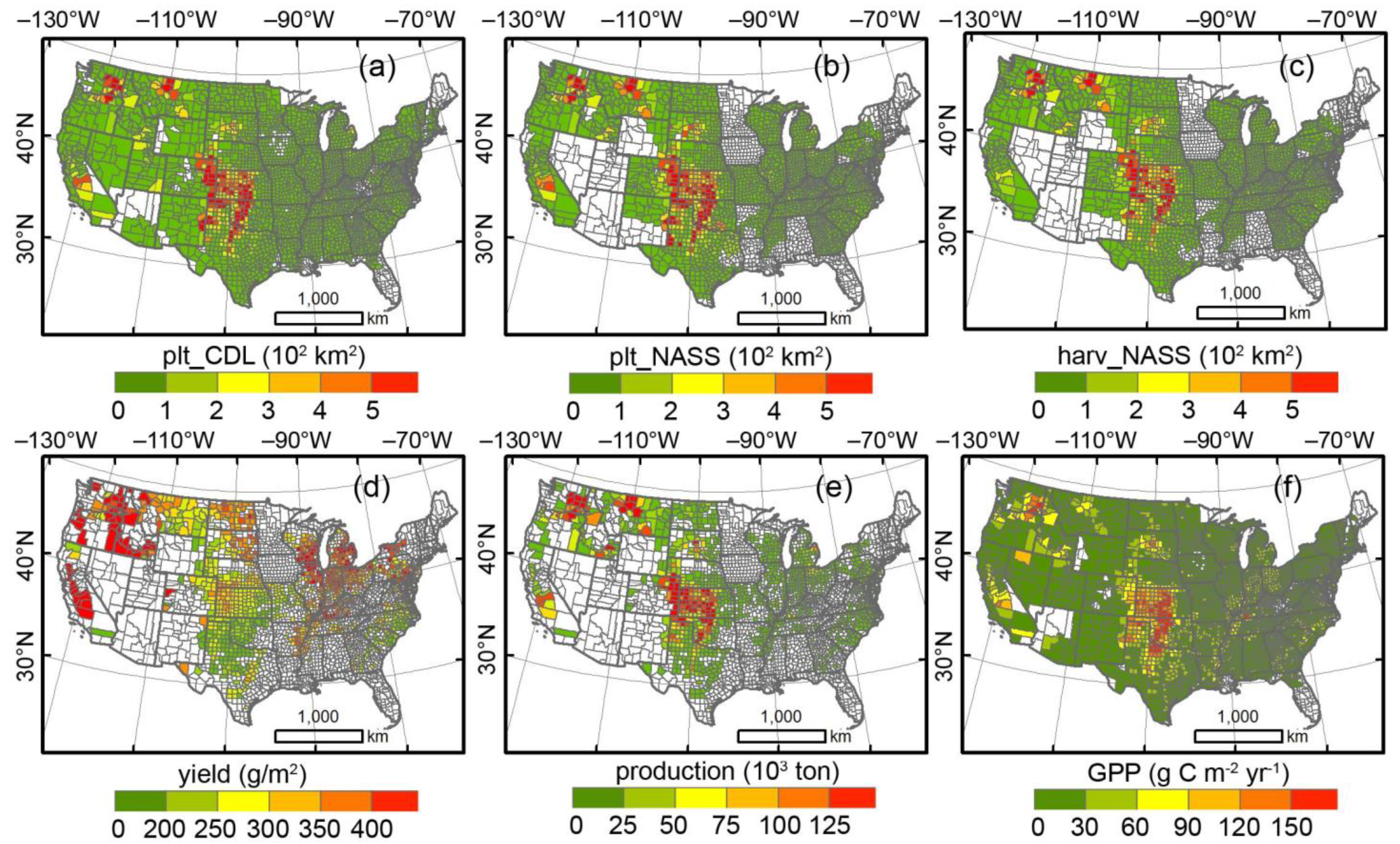
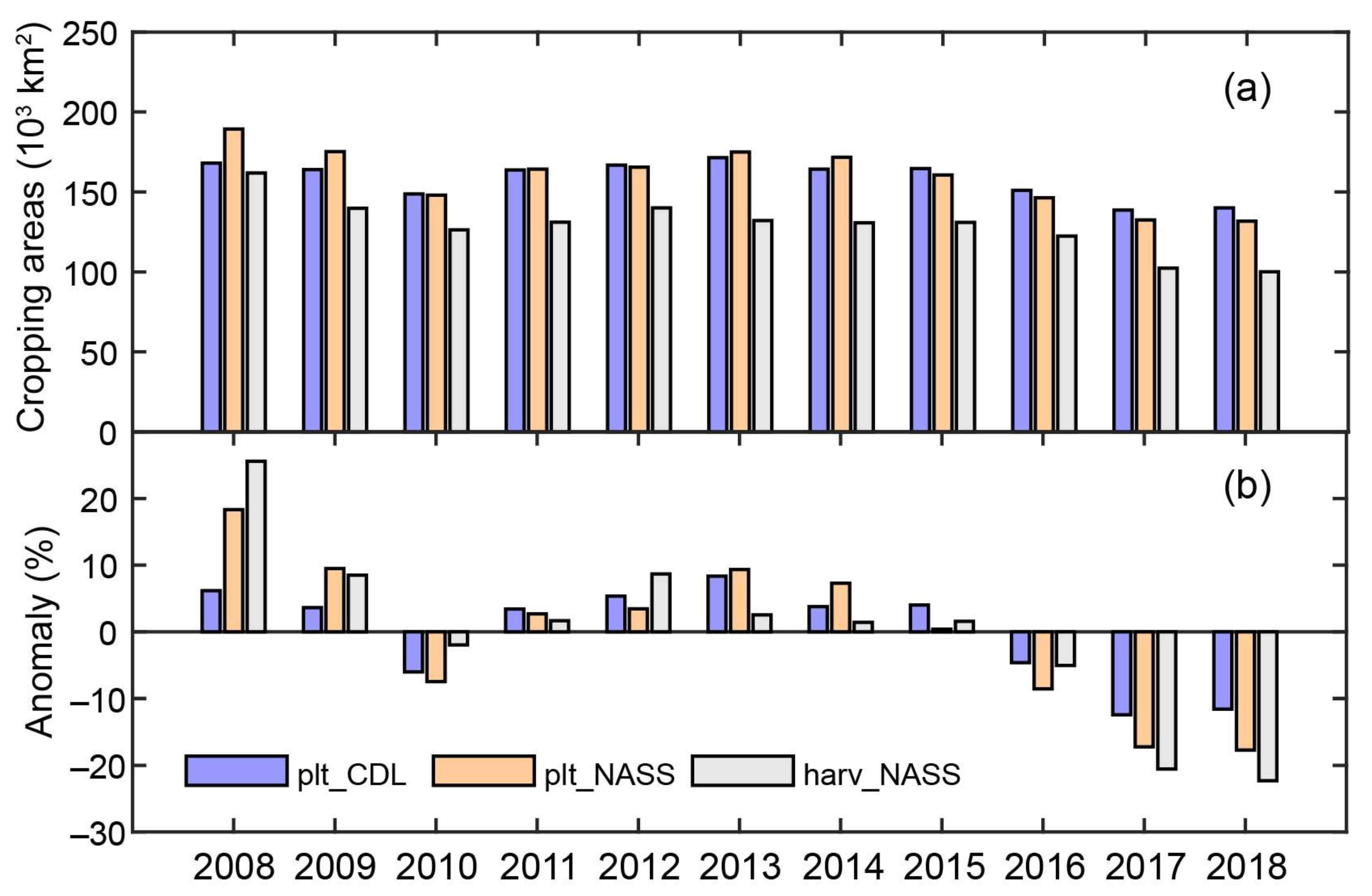
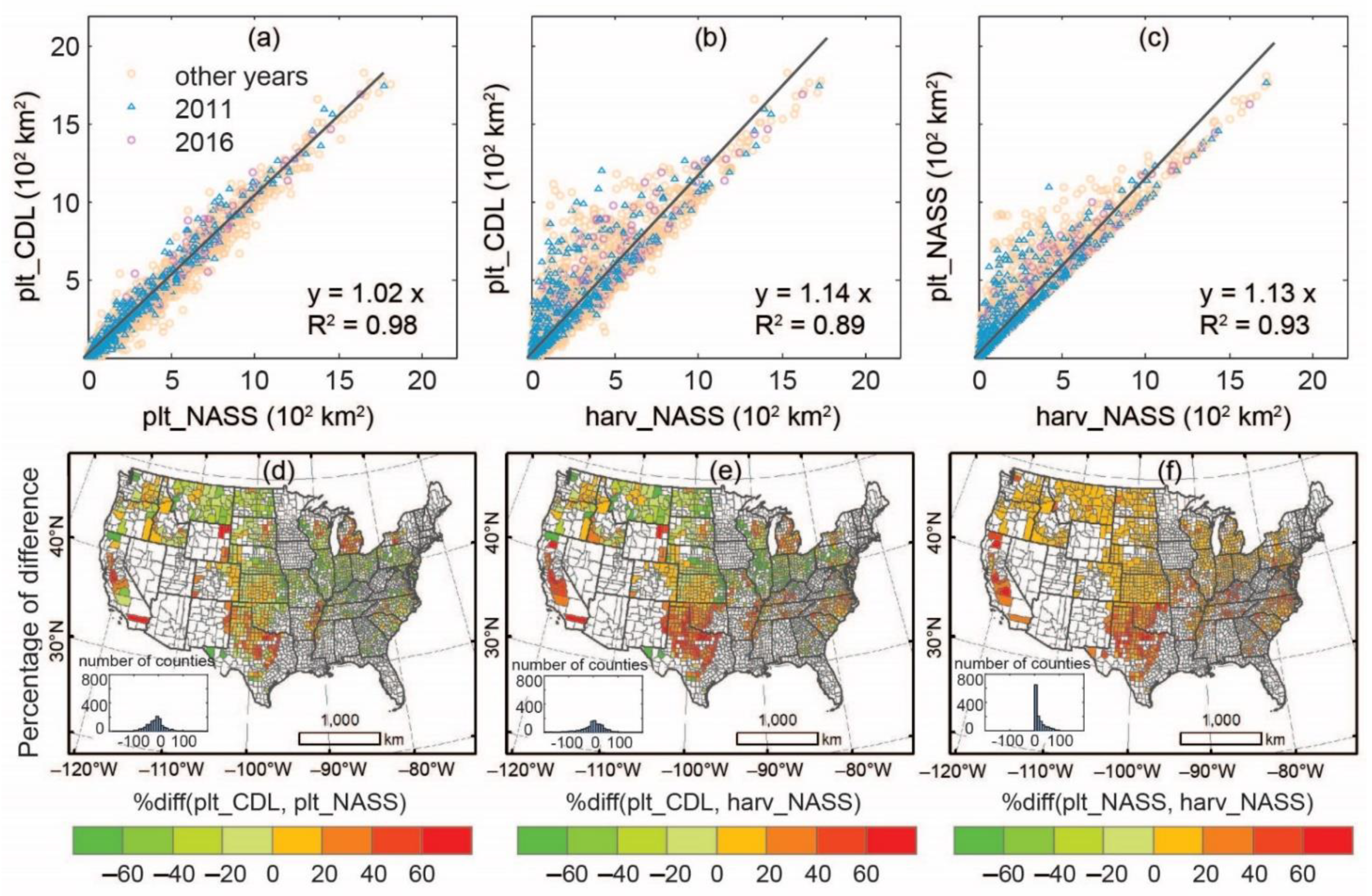
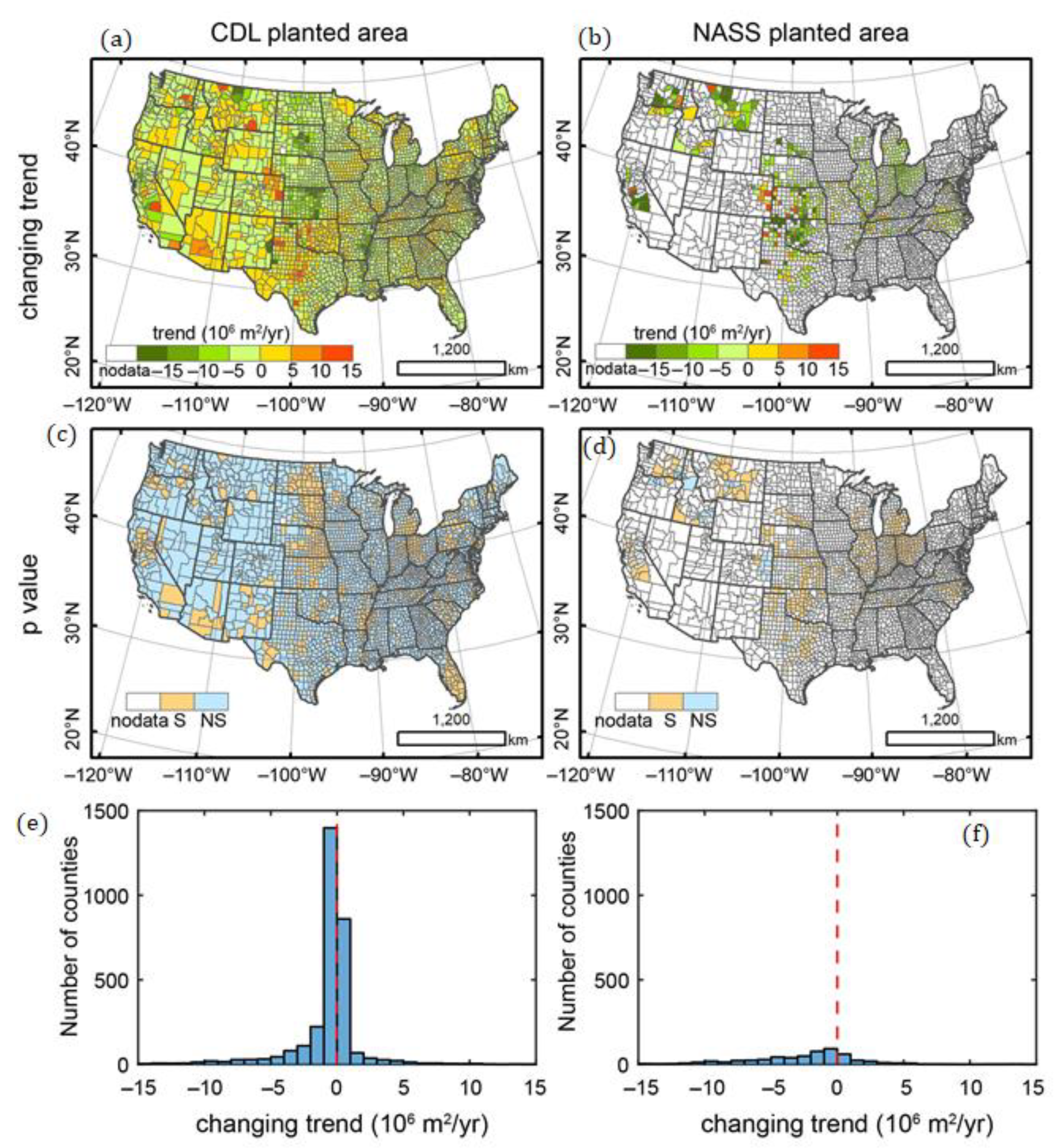


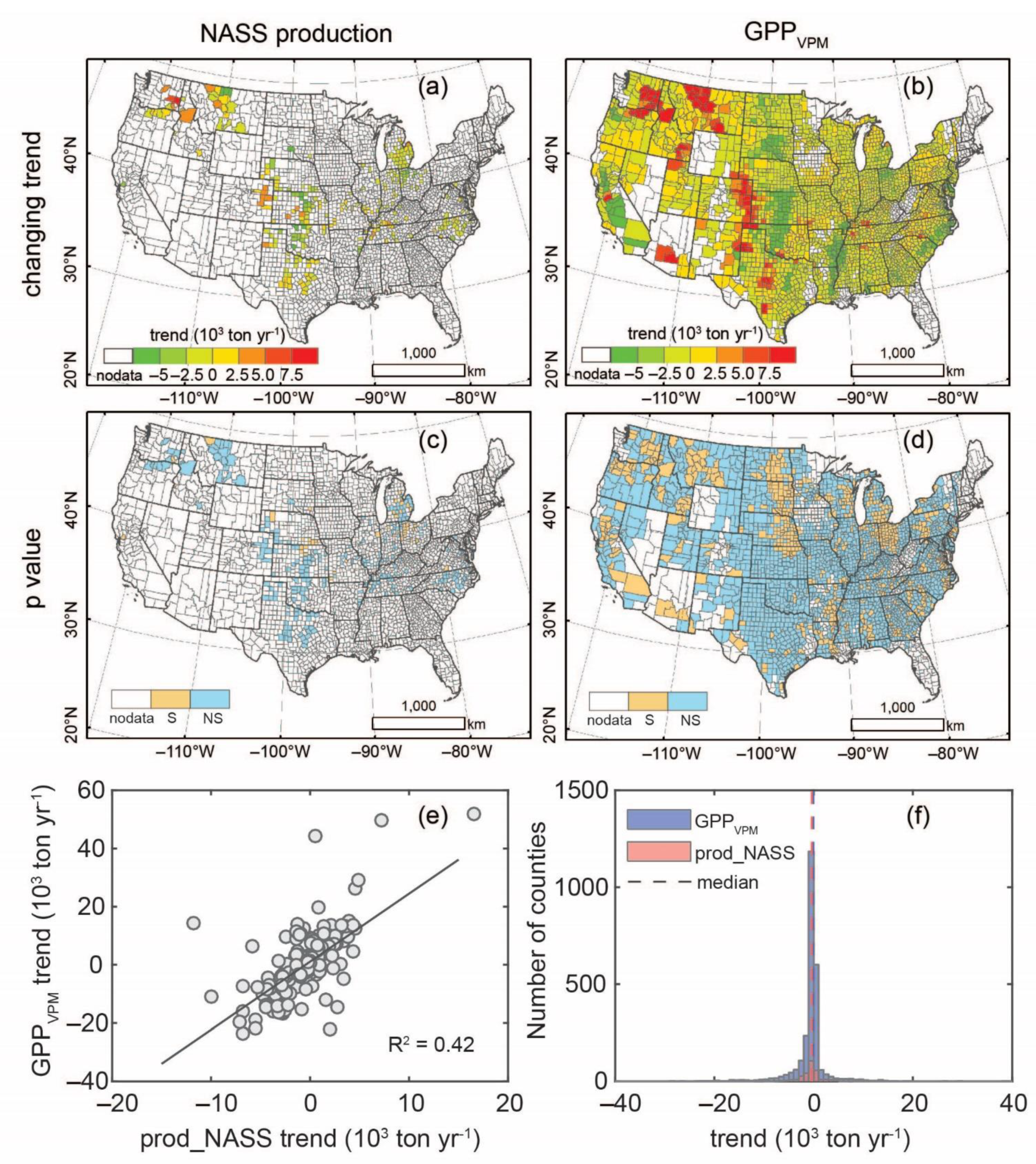
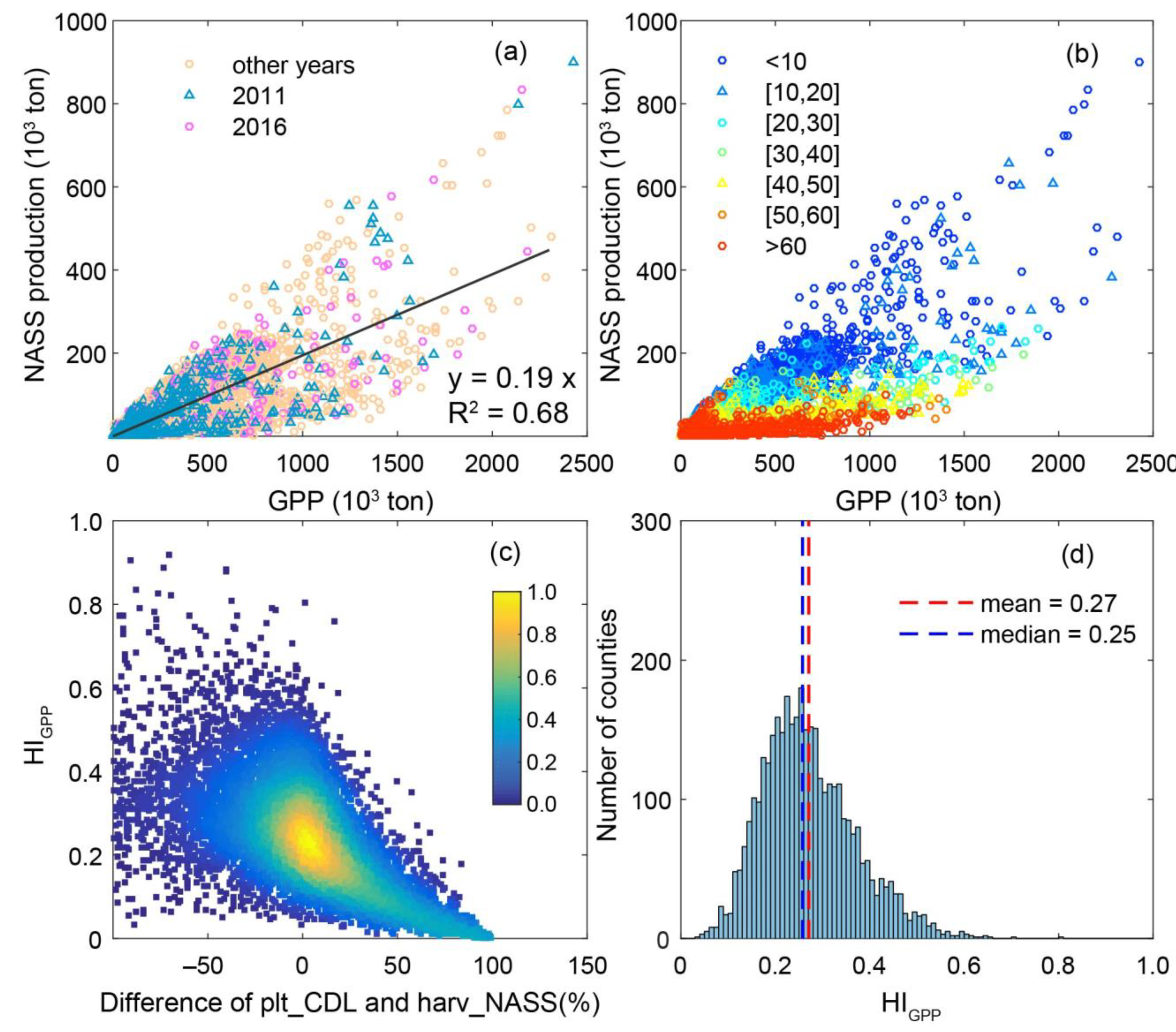
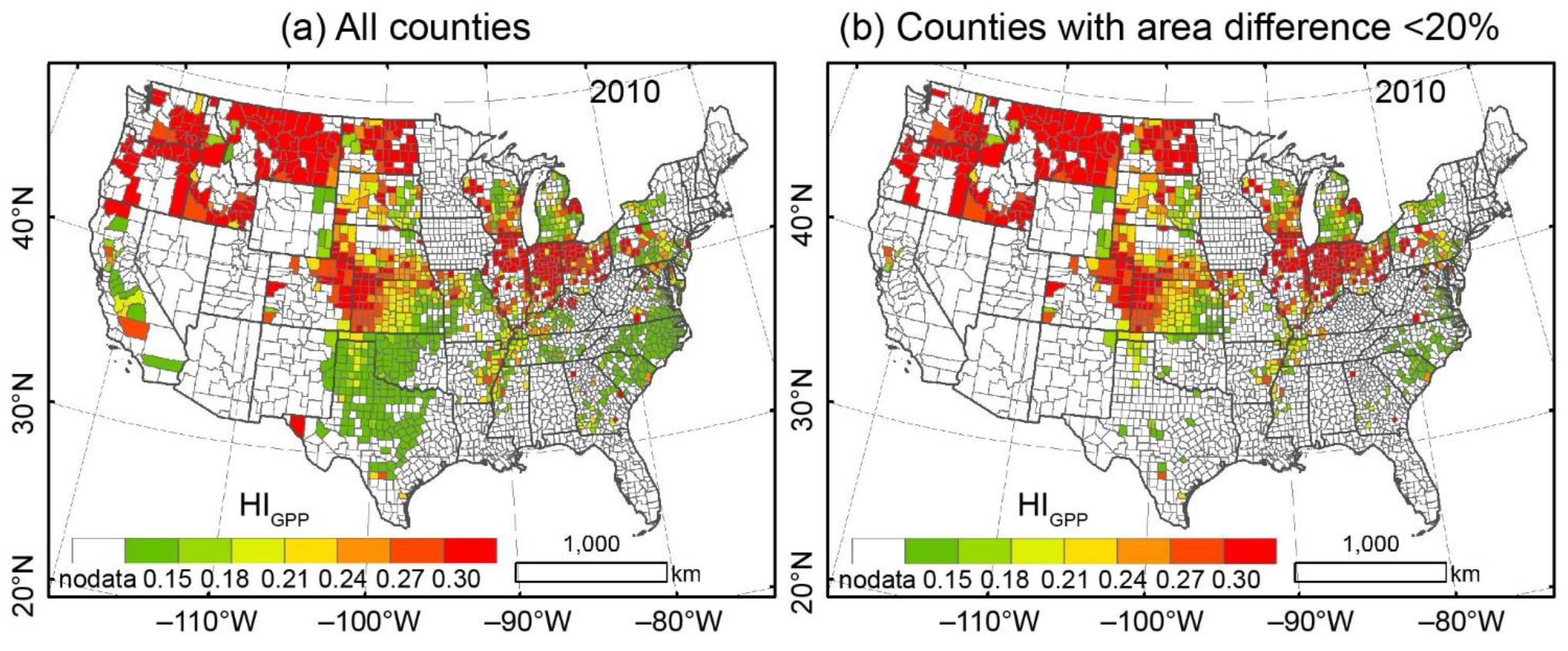
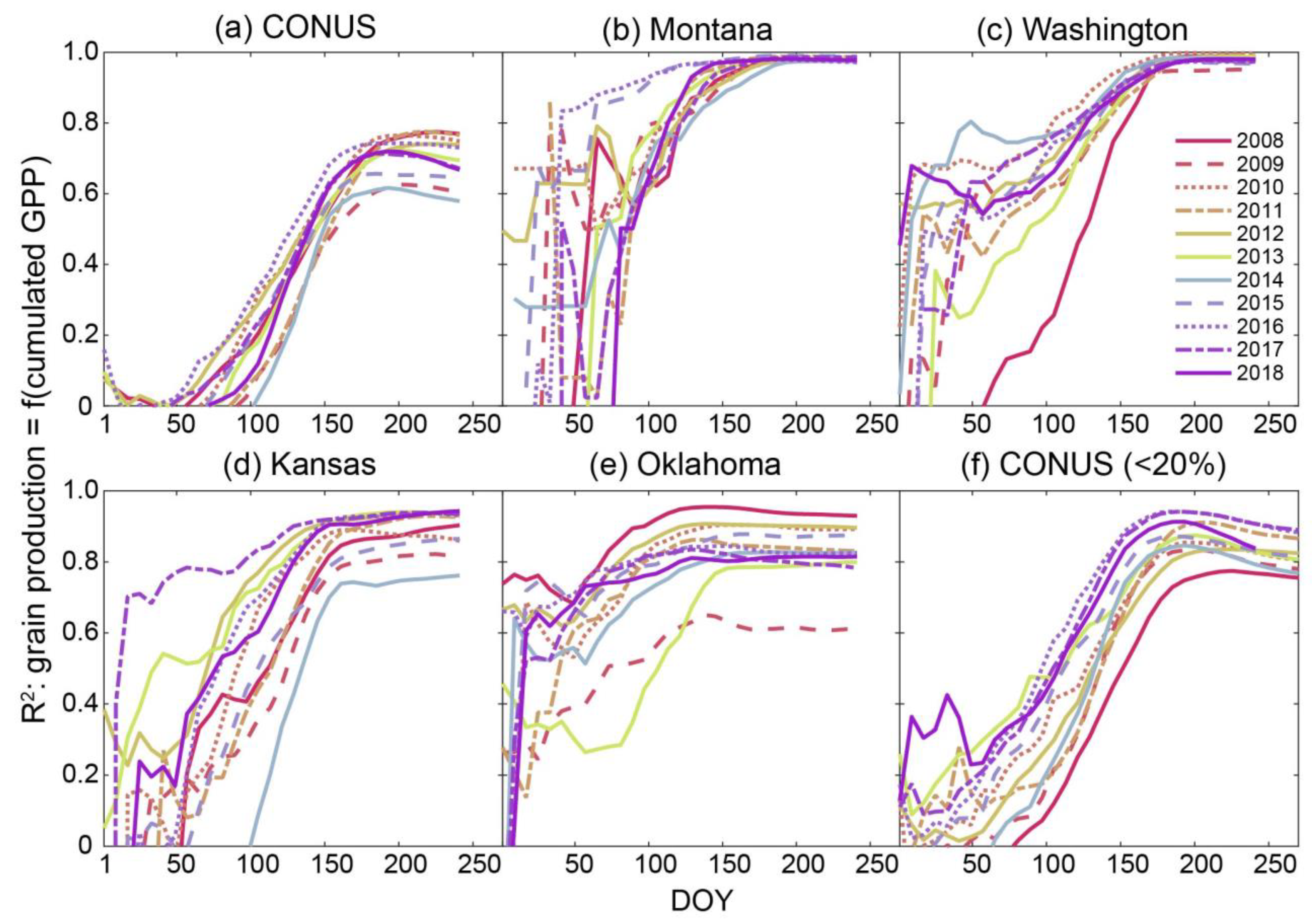
| Year | plt_CDL vs. plt_NASS | plt_CDL vs. harv_NASS | plt_NASS vs. harv_NASS | |||||||||
|---|---|---|---|---|---|---|---|---|---|---|---|---|
| Slope | R2 | Bias (102 km2) | RMSE (102 km2) | Slope | R2 | Bias (102 km2) | RMSE (102 km2) | Slope | R2 | Bias (102 km2) | RMSE (102 km2) | |
| 2008 | 0.96 | 0.97 | –12.22 | 280.66 | 1.07 | 0.94 | 3.82 | 266.03 | 1.11 | 0.96 | 16.03 | 280.66 |
| 2009 | 0.99 | 0.99 | –6.46 | 306.28 | 1.11 | 0.87 | 16.84 | 286.65 | 1.13 | 0.90 | 23.30 | 306.28 |
| 2010 | 1.02 | 0.99 | 1.13 | 292.75 | 1.12 | 0.95 | 15.93 | 279.13 | 1.11 | 0.97 | 14.80 | 292.75 |
| 2011 | 1.02 | 0.99 | 0.75 | 287.00 | 1.15 | 0.86 | 23.09 | 268.17 | 1.14 | 0.90 | 22.34 | 287.00 |
| 2012 | 1.02 | 0.99 | 1.67 | 300.82 | 1.10 | 0.91 | 17.68 | 288.64 | 1.09 | 0.95 | 16.01 | 300.82 |
| 2013 | 1.01 | 0.99 | –1.11 | 301.23 | 1.15 | 0.87 | 22.61 | 279.99 | 1.14 | 0.89 | 23.72 | 301.23 |
| 2014 | 0.97 | 0.98 | –4.41 | 302.44 | 1.13 | 0.84 | 21.75 | 275.66 | 1.18 | 0.88 | 26.16 | 302.44 |
| 2015 | 1.06 | 0.99 | 5.12 | 321.55 | 1.19 | 0.93 | 26.63 | 303.82 | 1.14 | 0.96 | 21.51 | 321.55 |
| 2016 | 1.06 | 0.98 | 5.54 | 311.76 | 1.17 | 0.92 | 23.35 | 296.98 | 1.11 | 0.96 | 17.81 | 311.76 |
| 2017 | 1.07 | 0.97 | 6.33 | 298.89 | 1.21 | 0.87 | 29.65 | 281.70 | 1.15 | 0.94 | 23.31 | 298.89 |
| 2018 | 1.09 | 0.98 | 8.90 | 303.80 | 1.22 | 0.84 | 34.24 | 285.68 | 1.14 | 0.90 | 25.34 | 303.80 |
| Year | prod_NASS vs. plt_CDL | prod_NASS vs. plt_NASS | prod_NASS vs. harv_NASS | |||||||||
|---|---|---|---|---|---|---|---|---|---|---|---|---|
| Slope | R2 | Bias (103 ton) | RMSE (103 ton) | Slope | R2 | Bias (103 ton) | RMSE (103 ton) | Slope | R2 | Bias (103 ton) | RMSE (103 ton) | |
| 2008 | 257.56 | 0.80 | 5.02 | 74.06 | 251.73 | 0.81 | 5.65 | 73.27 | 293.28 | 0.89 | 1.17 | 79.10 |
| 2009 | 214.09 | 0.66 | 4.65 | 71.02 | 215.73 | 0.69 | 4.46 | 71.25 | 273.40 | 0.86 | –2.45 | 80.06 |
| 2010 | 257.45 | 0.80 | 1.12 | 80.36 | 265.18 | 0.82 | 0.26 | 81.46 | 306.04 | 0.89 | –4.26 | 87.52 |
| 2011 | 215.92 | 0.60 | 3.51 | 70.60 | 225.97 | 0.63 | 2.33 | 71.93 | 290.31 | 0.79 | –5.22 | 81.19 |
| 2012 | 243.86 | 0.75 | 2.98 | 79.01 | 256.14 | 0.79 | 1.48 | 80.81 | 293.26 | 0.87 | –3.03 | 86.51 |
| 2013 | 221.88 | 0.61 | 4.56 | 74.68 | 227.6 | 0.63 | 3.85 | 75.47 | 296.46 | 0.82 | –4.64 | 85.83 |
| 2014 | 181.54 | 0.56 | 5.81 | 60.39 | 179.37 | 0.57 | 6.06 | 60.10 | 244.45 | 0.77 | –1.54 | 69.66 |
| 2015 | 197.58 | 0.72 | 3.57 | 69.65 | 213.49 | 0.76 | 1.49 | 72.19 | 256.62 | 0.85 | –4.14 | 79.55 |
| 2016 | 278.65 | 0.75 | 2.53 | 95.96 | 305.26 | 0.80 | –0.75 | 100.07 | 359.77 | 0.89 | –7.45 | 109.08 |
| 2017 | 244.46 | 0.67 | 1.87 | 83.97 | 275.46 | 0.75 | –1.94 | 88.52 | 343.50 | 0.88 | –10.30 | 99.43 |
| 2018 | 218.49 | 0.59 | 2.08 | 79.48 | 249.05 | 0.65 | –1.73 | 83.93 | 319.78 | 0.8 | –10.53 | 95.35 |
| Year | Slope | R2 | Bias (103 ton) | RMSE (103 ton) |
|---|---|---|---|---|
| 2008 | 0.306 | 0.711 | 5.374 | 72.506 |
| 2009 | 0.298 | 0.591 | 4.899 | 69.652 |
| 2010 | 0.320 | 0.741 | 1.736 | 79.246 |
| 2011 | 0.343 | 0.688 | 1.404 | 71.655 |
| 2012 | 0.254 | 0.694 | 4.260 | 78.217 |
| 2013 | 0.290 | 0.692 | 3.840 | 76.209 |
| 2014 | 0.295 | 0.609 | 3.397 | 60.451 |
| 2015 | 0.229 | 0.660 | 4.071 | 68.616 |
| 2016 | 0.304 | 0.746 | 2.831 | 96.078 |
| 2017 | 0.306 | 0.713 | 0.657 | 84.463 |
| 2018 | 0.321 | 0.709 | 0.356 | 81.633 |
| Relative Difference | Slope | R2 | Bias (103 ton) | RMSE (103 ton) | Number of Counties |
|---|---|---|---|---|---|
| [0,10] | 0.27 | 0.87 | 0.42 | 113.62 | 3715 |
| [10,20] | 0.22 | 0.83 | 3.07 | 71.80 | 2501 |
| [20,30] | 0.17 | 0.79 | 4.48 | 48.47 | 1609 |
| [30,40] | 0.14 | 0.80 | 4.28 | 40.65 | 1076 |
| [40,50] | 0.11 | 0.81 | 3.47 | 34.56 | 691 |
| [50,60] | 0.10 | 0.83 | 3.48 | 38.22 | 519 |
| >60 | 0.07 | 0.69 | 0.44 | 26.57 | 2127 |
Publisher’s Note: MDPI stays neutral with regard to jurisdictional claims in published maps and institutional affiliations. |
© 2021 by the authors. Licensee MDPI, Basel, Switzerland. This article is an open access article distributed under the terms and conditions of the Creative Commons Attribution (CC BY) license (https://creativecommons.org/licenses/by/4.0/).
Share and Cite
Wu, X.; Xiao, X.; Steiner, J.; Yang, Z.; Qin, Y.; Wang, J. Spatiotemporal Changes of Winter Wheat Planted and Harvested Areas, Photosynthesis and Grain Production in the Contiguous United States from 2008–2018. Remote Sens. 2021, 13, 1735. https://doi.org/10.3390/rs13091735
Wu X, Xiao X, Steiner J, Yang Z, Qin Y, Wang J. Spatiotemporal Changes of Winter Wheat Planted and Harvested Areas, Photosynthesis and Grain Production in the Contiguous United States from 2008–2018. Remote Sensing. 2021; 13(9):1735. https://doi.org/10.3390/rs13091735
Chicago/Turabian StyleWu, Xiaocui, Xiangming Xiao, Jean Steiner, Zhengwei Yang, Yuanwei Qin, and Jie Wang. 2021. "Spatiotemporal Changes of Winter Wheat Planted and Harvested Areas, Photosynthesis and Grain Production in the Contiguous United States from 2008–2018" Remote Sensing 13, no. 9: 1735. https://doi.org/10.3390/rs13091735
APA StyleWu, X., Xiao, X., Steiner, J., Yang, Z., Qin, Y., & Wang, J. (2021). Spatiotemporal Changes of Winter Wheat Planted and Harvested Areas, Photosynthesis and Grain Production in the Contiguous United States from 2008–2018. Remote Sensing, 13(9), 1735. https://doi.org/10.3390/rs13091735









